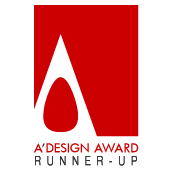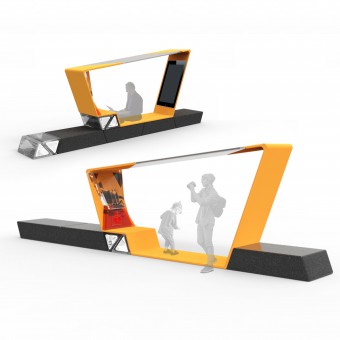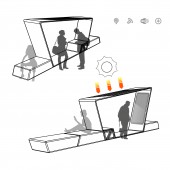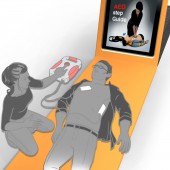DESIGN NAME:
MODU
PRIMARY FUNCTION:
Multifunctional 、shelter
INSPIRATION:
The from of this design is inspired by Ox-eye window,(known as Laohuchuang), which commonly features in Tingzijian. Tingzijian (a small backroom over a kitchen) is the typical element of Shikumen (a shanghaies vernacular building combining western and Chinese elements). The small volume of Tingzijian offers opportunities of space division. We abstracted the form of such windows to symbolize the history and culture of the city, hence the name MODU, which is a nickname of Shanghai.
UNIQUE PROPERTIES / PROJECT DESCRIPTION:
The design aims to improve the quantity and quality of public resting facilities in Gray Spaces in modern cities. It tackles problems, such as lack of public wifi, charging points, first-aid kits, and shelters, through combination of public chairs and shelters. It adapts modulus, humanized design philosophy, network technology, green energy, and regeneration technology, providing a modern shelter that contains means of relaxation and entertainment.
OPERATION / FLOW / INTERACTION:
Solar panels are placed on the top of the functional unit to generate energy for the optical unit and wireless chargers.A safety hammer is provided to remove the glass barrier, to take out AED. As the barrier is being removed, signals would be sent to hospitals. Meanwhile, instructions to AED would be played on the screen to the side.An APP is designed in addition to locate MODU units nearby, and to monitor AED equipments.
PROJECT DURATION AND LOCATION:
January 2017- August 2017 Shanghai
FITS BEST INTO CATEGORY:
Social Design
|
PRODUCTION / REALIZATION TECHNOLOGY:
basic unit: concrete, recycled paper and resin
optical unit: LED light, and polystyrene plastic board
functional unit: metal, and resin
the functional unit contains solar power, wireless charger, AED kit, and interactive multimedia
SPECIFICATIONS / TECHNICAL PROPERTIES:
basic unit bottom 1840mmX1000mm
top 1599mmX1000mm
height 450mm
Optical unit 650mmX1000mmX450mm
Functional unit bottom 1820mmX1000mm
Top 4000mm
height lowest point 1900mm Highest point 2500mm
TAGS:
gray spaces, shelter, humanization, regeneration, modulus design, natural texture, Internet technology
RESEARCH ABSTRACT:
Field research and online questionnaire were both taken out. The research analyzed typical activities taking place in Gray Spaces in modern cities. The design improves quantity and quality of public facilities, by making them more humanized. 134 people took the online questionnaire, among which 44.78% are 18-25 years old, 20.15% are 25-35 years old, and 21.64% are 35-45 years old. Field research took place in 6 business centres on underground Line 2 route, such as the People’s Square, Jing’an Temple, Century Avenue. We realized that there is lack of AED, of waiting areas, of charging points, of public wifi, and of resting areas. Therefore, we tackled such problems to provide a humanized shelter design, which also accommodates AED equipments.
CHALLENGE:
Shanghai is a highly modernized city, which caused difficulties in abstracting and symbolizing the history and culture of the city, and in optimizing the form and size of the design, so it responds to different spatial scales and visitors volume. Therefore, I abstracted the form of Ox-eyed windows in the vernacular Shanghai architecture - Shikumen, as a gesture of nostalgia to remind people of the culture of the city. A modulus design approach is used to ensure that the design meets different spatial requirements.
ADDED DATE:
2017-08-04 09:53:04
TEAM MEMBERS (2) :
Lin Xu and Ying Zhang
IMAGE CREDITS:
Lin Xu, 2017.
PATENTS/COPYRIGHTS:
Waiting for patent number
|









